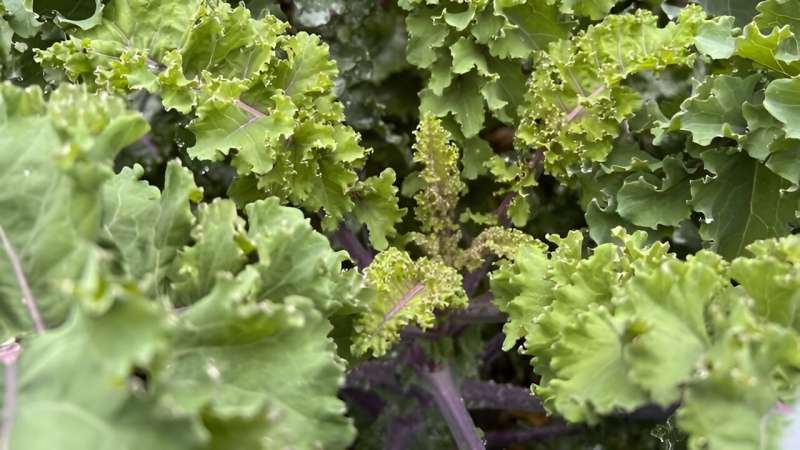This article has been reviewed according to Science X's editorial process and policies. Editors have highlighted the following attributes while ensuring the content's credibility:
fact-checked
proofread
Investigating effect of cold temperatures on genetically different varieties of kale

Kale is considered particularly healthy due, among other things, to its high secondary plant compound content, including the glucosinolates that give the vegetable its typical cabbage flavor. Researchers from Oldenburg and Bremen have now determined that the exact composition of these substances, also known as mustard oil glycosides, depends on environmental factors—in particular temperature—as well as genetic factors.
The research team led by Dr. Christoph Hahn and Professor Dr. Dirk Albach, both from the University of Oldenburg, has now published the results of their study in the journal Horticulturae. Their findings indicate that in some kale varieties the concentration of glucosinolates increases in cold temperatures, whereas in others it decreases. "To obtain plants with an improved nutritional value, considering both temperature and the choice of cultivar is crucial," Hahn says.
In an earlier study the biologists had already demonstrated that the 150 or so kale varieties that exist worldwide can be assigned to several genetically different groups which also differ in terms of appearance, taste, color and composition. One group comprises kale varieties with curly leaves such as those typically cultivated in Northern Germany.
Another group consists of Italian varieties with a milder taste and elongated, dark leaves known as "Lacinato kale," "palm kale" or "black cabbage." A third group is made up of varieties with broad, smooth leaves which are commonly grown in the United States and are more similar to the wild form or "feral-type" cabbage.
Chemical protection from caterpillars and snails
In the current study, Hahn's team investigated the impact of cold temperatures on the glucosinolate composition in kale leaves. When the leaves are crushed, the substances they contain are converted into mustard oils (isothiocyanates) which protect the vegetable from predators such as caterpillars and snails.
These substances are also responsible for the vegetable's characteristic, in some cases bitter and pungent taste. Glucosinolate levels are particularly high in feral-type kale and tend to be considerably lower in Lacinato varieties.
For their study the researchers selected the three varieties "Frostara," "Palmizio" and "Helgoländer," which can be assigned to the curly kale, Lacinato kale and feral-type kale groups, respectively. They grew 45 specimens of each variety in a climate chamber at the University and exposed the adult plants to temperatures of 2°C for one week.
Analyses of glucosinolate levels and composition were performed at warm temperatures, after 12 hours of cold exposure, and after seven days of cold exposure. Concentrations of seven different glucosinolates were performed at all three time-points using a mass spectrometer.
Lacinato kale produces more glucosinolates at low temperatures
The scientists found that total glucosinolate levels increased at low temperatures in both the curly kale and Lacinato samples, but decreased in the feral type. This came as a surprise for the team. "Based on our previous experiments we would not have expected the Lacinato kale to react in exactly the same way as the curly variety, since it is adapted to different climatic conditions," Hahn commented.
How these results affect the taste of kale was not investigated in the study. "As regards taste, not just the glucosinolates but also the sugar content is decisive," Hahn explained. The biologist already demonstrated in a study published in 2020 that levels of sugar compounds in kale leaves also increase at low temperatures—however not only at sub-zero temperatures, as is often assumed, but also at temperatures in the above-zero single-digit range.
More information: Christoph Hahn et al, A Cold Case—Glucosinolate Levels in Kale Cultivars Are Differently Influenced by Cold Temperatures, Horticulturae (2023). DOI: 10.3390/horticulturae9090953
Provided by Carl von Ossietzky Universität Oldenburg





















